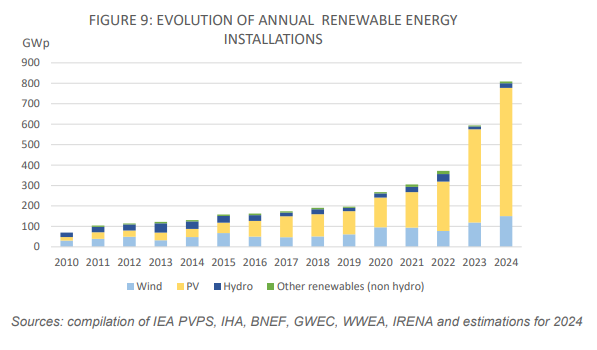Cumulative solar installations climbed 37.5% from 1.6 TW to 2.2 TW last year, said the International Energy Agency.
Solar energy production reached more than 10% of the world’s electricity consumption for the first time in 2024, said an annual report from the International Energy Agency (IEA).
Cumulative global solar installations grew 37.5% from 1.6 TW to 2.2 TW in 2024, posting a record year of over 600 GW of installations. Global solar capacity has nearly doubled in only two years, rapidly growing from just under 1.2 TW of cumulative installations through 2022 to 2.2 TW today.
The United States added a record 47.1 GW, reaching 224 GW of cumulative installations. China led all nations globally with 357 GW installed, or nearly 60% of new global capacity, reaching over 1 TW of cumulative installed capacity in 2024.
Solar reached about 7.9% percent of total electricity production in the United States in 2024. The leading nations in terms of share in electricity generation mix were Greece (27.9%), Netherlands (25.5%), and Spain (24%).
Solar contributed more than 75% of new renewable capacity and nearly 60% of generation from new renewable capacity in 2024, said IEA.

IEA said a “half dozen” of countries are approaching or exceeding 20% of consumption being matched with solar production. For these countries, power curtailment is increasingly prevalent and investments in grid decongestion and interconnections, as well as flexibility, storage and sector coupling will be needed in the future to take advantage of peak capacity, said IEA.
IEA said as solar’s share in the electricity supply increases, storage is becoming “an important enabler.” Energy storage helps to smooth intermittent peak production, reduce grid capacity costs and provide a range of services that allow solar-plus-storage to replace traditional power plants.
Solar also enables further decarbonization of transport, buildings, and more as an inexpensive source of electricity.
“Cleaner energy systems can be built on renewable energies for electricity supply and the electrification of previously fossil fuel powered uses such as heating and transport,” said IEA.
Policies to support hybrid solar-plus-storage projects both at the utility-scale and residential sector have advanced in major markets, including the U.S., Australia, and India, said IEA. Global battery capacity is estimated to have increased by 150% in 2024, said the report.
“Combining high volumes of variable renewable energy with storage is proving to be a cost-effective, cleaner solution than maintaining often aging coal power plants or investing in new gas turbines, with supply subject to geopolitical instability, as proven over the past two years,” said the report.
Popular content




